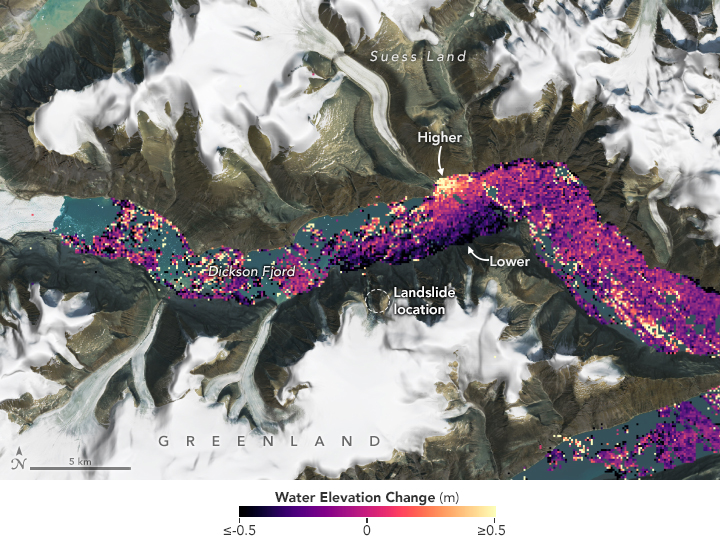
Sizing Up a Greenland Tsunami
Downloads
- greenlandtsunami_swot_20230917_lrg.jpg (1440x1090, JPEG)
Metadata
- Sensor(s):
- Landsat 9 - OLI-2
- SWOT - KaRIn
- Data Date: August 6, 2023 - September 17, 2023
- Visualization Date: November 5, 2024
An international satellite mission detected the unique contours of a tsunami that sloshed within the steep walls of a fjord in Greenland in September 2023. Triggered by a massive rockslide, the tsunami generated a seismic rumble that reverberated around the world for nine days. A research team that included seismologists, geophysicists, and oceanographers recently reported on the event after a year of analyzing data.
The SWOT (Surface Water and Ocean Topography) satellite, a collaboration between NASA and France’s CNES (Centre National d’Études Spatiales), collected water elevation measurements in Dickson Fjord on September 17, 2023, the day after the initial rockslide and tsunami. The data were compared with measurements made under normal conditions a few weeks prior, on August 6, 2023.
In this data visualization, orange and yellow indicate higher-than-normal water levels, and purple and black indicate lower levels. For context, water elevation measurements are overlaid on an image of the fjord acquired by the OLI-2 (Operational Land Imager-2) on the Landsat 9. The data suggest that water levels along the north side of the fjord were as much as 1.2 meters (4 feet) higher than on the south side at some points.
“SWOT happened to fly over at a time when the water had piled up pretty high against the north wall of the fjord,” said Josh Willis, a sea level researcher at NASA’s Jet Propulsion Laboratory in Southern California. “Seeing the shape of the wave—that’s something we could never do before SWOT.”
In a paper published recently in Science, researchers traced a seismic signal back to a tsunami that began when more than 25 million cubic meters (880 million cubic feet) of rock and ice fell into Dickson Fjord. Part of a network of channels on Greenland’s eastern coast, the fjord is about 540 meters (1,772 feet) deep and 2.7 kilometers (1.7 miles) wide, with walls taller than 1,830 meters (6,000 feet).
Far from the open ocean, in a confined space, the energy of the tsunami’s motion had limited opportunity to dissipate, so the wave moved back and forth about every 90 seconds for nine days. It caused tremors recorded on seismic instruments thousands of miles away.
From about 900 kilometers (560 miles) above, SWOT uses its sophisticated Ka-band Radar Interferometer (KaRIn) instrument to measure the height of nearly all water on Earth’s surface, including the ocean and freshwater lakes, reservoirs, and rivers.
“This observation also shows SWOT’s ability to monitor hazards, potentially helping in disaster preparedness and risk reduction,” said SWOT program scientist Nadya Vinogradova Shiffer at NASA Headquarters.
It can also see into fjords, as it turns out.
“The KaRIn radar’s resolution was fine enough to make observations between the relatively narrow walls of the fjord,” said Lee-Lueng Fu, the SWOT project scientist. “The footprint of the conventional altimeters used to measure ocean height is too large to resolve such a small body of water.”
References
- NASA’s Jet Propulsion Laboratory (2024, October 31) International SWOT Satellite Spots Planet-Rumbling Greenland Tsunami. Accessed November 5, 2024.
- Svennevig, K., et al. (2024) A rockslide-generated tsunami in a Greenland fjord rang Earth for 9 days. Science, 385(6714), 1196–1205.
NASA Earth Observatory image by Lauren Dauphin, using SWOT data provided by the SWOT science team, Landsat data from the U.S. Geological Survey, and Digital Elevation Model data from ArcticDEM. Story by Andrew Wang, NASA’s Jet Propulsion Laboratory, adapted for NASA Earth Observatory.
This image record originally appeared on the Earth Observatory. Click here to view the full, original record.